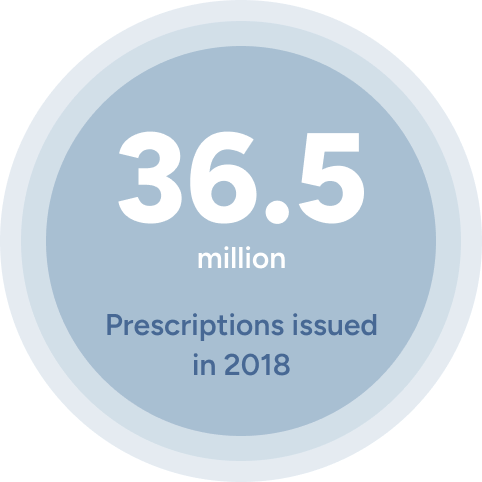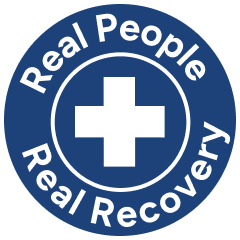Home / Drug & Alcohol Rehab Programs Across New England / Tramadol Abuse: Addiction Signs & Treatment Options
Tramadol is a prescription medication commonly used to treat chronic pain and related symptoms. Doctors commonly prescribe about 400 mg per day to a patient, and its effects start to show after about four to six hours.
Like any other painkiller, Tramadol activates the opioid receptors in the spinal cord and other parts of the body, dulling pain sensations and enhancing pleasure. It is also used as an antidepressant medication due to its reuptake inhibition character of norepinephrine and serotonin chemicals into nerve terminals. For this reason, the drug is widely used as a prescription opioid medication, commonly sold under the Ultracet, Ultram, and ConZip names to treat moderate to severe pains.
In 2018, the Drug Enforcement Administration estimated that medical professionals issued about 36.5 million prescriptions to individuals. Due to its availability and ability to give a relaxing and happier sensation, Tramadol is easily abused, resulting in addiction and dependency. In fact, the Drug Enforcement Administration report in 2012 indicates that an estimate of over 3 million people aged 12 years and above have abused Tramadol at one point in their lives.

Close family and friends may notice signs such as:

Tramadol has less addiction potential compared to other opioid medications. It is a Schedule IV substance, while other painkillers fall under Schedule II. Due to its calming and relaxing effects, individuals tend to abuse it by taking an excess dose or taking it without prescription. Prescription users can also become addicted, but they may fail to realize it until they stop using the drug. When used for a long time, individuals become tolerant of the drug, requiring them to use more for it to work effectively. Tramadol can also cause dependence, resulting in abuse to feed the cravings and avoid withdrawal symptoms. For those who use the drug for recreational purposes, the addiction occurs faster and is more evident.
Some of the common signs of Tramadol addiction include:
Unlike other opioid painkillers, Tramadol effects take time. The effects are felt after four to six hours. As a result, most people assume the drug is not working effectively, tempting them to take more and resulting in an overdose. The natural way of Tramadol absorption is ingestion through the gastrointestinal system. When individuals crush the tablets and snort or smoke them, the drug goes straight to the bloodstream, making it more likely to result in an overdose.
Mixing Tramadol with other drugs such as alcohol and opioids can also result in an overdose. Medical practitioners advise patients to not take alcohol while taking Tramadol for medication purposes. When both drugs are taken in small amounts, the effects are limited. However, there may be serious side effects as the combination alters crucial body functioning such as blood pressure, heart rate, and body temperature regulation.
Signs of a Tramadol overdose include:
A tramadol overdose should be treated as a medical emergency as it presents life-threatening effects. You should seek help from a professional immediately if you suspect an overdose. To reverse the overdose effects, professionals usually use an opioid antagonist drug such as Naloxone.
Anyone can be at risk of Tramadol addiction. However, individuals with a Tramadol prescription are at a higher risk. Tramadol gives a euphoric and relaxing feeling. Prescription users can become dependent or accidentally addicted as their bodies become tolerant to the drug, causing them to want more to continue feeling good.
Tramadol is also used for animal use. Individuals who work with animals such as veterinarians have access to this drug, increasing their chances of abusing it.
Additional factors that can lead to Tramadol addiction include mental illness, abuse or trauma, chronic pain, and drug addiction history.
Addiction is an illness that progresses over time. Immediate treatment from a professional can reverse the effects, but the first step to recovery recognizes you need help first. Some of the common signs that you need immediate help with include the following:

Most people addicted to drugs, including Tramadol, are not aware of their condition, while others are in self-denial. Loved ones should offer drug addiction intervention with love and patience. Addiction is a disease, so intervention should be carefully planned and executed for successful results.
If you have a loved one addicted to Tramadol, consider seeking professional help from an interventionist. He or she will prepare and guide you on what to say when to say it as well as how to handle possible reactions such as denial and aggressiveness.
Create a safe and comfortable space and thoughtfully plan your words before expressing your feelings to the individual suffering from addiction. Please encourage them to seek medical help. It is important to note that the recovery process is personal, so you cannot force your loved one to get better. Focus on making them feel comfortable discussing their struggles with you.
Individuals struggling with Tramadol addiction can seek help from a rehab facility to receive personalized care and treatment. Granite Recovery Centers helps clients overcome drug addiction through compassionate care and services. Our facility has over 10 years of experience helping patients in New England and beyond take back control of their lives by providing a continuum of services such as medical detox and evidence-based psychotherapies.
Different medical professionals treat Tramadol addiction in different ways. For the process to be effective, the patient has to be cooperative and willing to stick to the program even when the recovery process gets tough. Some of the treatment methods and options used during the recovery process include the following:
The first step toward Tramadol addiction recovery is medical detoxification. This is the process of eliminating harmful substances from the body in a safe environment. It is recommended to detox as part of an inpatient setup. Clinicians will closely monitor the withdrawal symptoms and offer assistance in case of an emergency. Granite Recovery Centers provides medical detoxification for people who do not need immediate medical intervention, are not a danger to themselves, and are capable of self-evacuation in the event of an emergency.
Some of the common withdrawal symptoms of Tramadol include sweating, insomnia, shivering, vomiting, nausea, and stomach cramps. In extreme cases, the patient may experience hallucinations, panic attacks, numbness, paranoia, and extreme anxiety.
Before the detox process begins, medical practitioners conduct a comprehensive evaluation such as blood tests to address underlying issues and develop a plan that meets the client’s specific needs. They may utilize drugs such as anti-anxiety and non-steroidal anti-inflammatory drugs to manage the withdrawal symptoms.
The detox process can take days or weeks, depending on the client’s recovery speed and stabilization levels. Once the detox process is complete, the patient enrolls in other treatment programs.
An important treatment component of addressing Tramadol addiction is therapy. Therapy sessions are promising avenues to discuss and learn the cause of the addiction, coping mechanisms, triggers and how to avoid them, and how to cope with cravings for long-term sobriety. Sessions are usually led by a counselor or psychiatrist and can be done individually, in groups, or with family. Granite Recovery Centers counselors utilize evidence-based treatment methods and therapies such as cognitive behavioral therapy during the recovery process. Therapies can be uncomfortable and extensive during the first weeks but tend to be less stressful as time elapses.
Some of the common types of therapies used in Tramadol treatment include:
Tramadol dependence can also be treated using multiple medications as part of a medication-assisted treatment (MAT) program. One of the most used drugs is methadone, which is widely prescribed to manage withdrawal symptoms without causing the patient to get high. Naltrexone and buprenorphine-naloxone medication are also used to treat Tramadol. Prescription is not necessary, especially if the chemical dependence is mild.
This level of care allows patients struggling with Tramadol addiction to get treatment while still meeting their daily obligations. It is suitable for individuals with moderate Tramadol addiction as they do not require much supervision. To get the best results, this program blends various treatment methods such as therapies and counseling. Depending on the level of addiction and the goals of the patient, a person can enroll in partial hospitalization or intensive outpatient programs. They both allow patients to go back home at the end of the day.
An inpatient treatment program is effective for patients with co-occurring disorders and severe Tramadol addictions. This level of care allows patients to recover without outside distractions, and it offers a high level of supervision and personalized care. These programs normally last between 28 to 90 days, depending on the recovery progress and the client’s needs. Granite Recovery Centers may extend the program if they do not reach their patient goals within 90 days. A successful program requires patients to strictly follow the rules and stick to the schedule.
During the recovery process, patients may find themselves falling back to using Tramadol. Relapse is part of the recovery process. Some practical tips to prevent Tramadol abuse relapse include eating nutritious foods, exercising regularly, getting enough sleep, and building a positive support network. It is also important to identify your triggers and avoid the people and places that remind you of Tramadol use.
An after-care program plays an essential role in the success of any addiction recovery process. It refers to the care provided and measures taken after the treatment process to enhance long-term sobriety. Some of the aftercare programs offered by Granite Recovery Centers include:
The 12-step program – This is a self-help group whereby individuals struggling with addiction meet regularly to discuss the physical, mental and spiritual struggles they face during their recovery process. Members share their experiences and everyone encourages one another to stay sober by hearing the success stories of the others. Going to these meetings helps you create a social network of individuals who share the same goals as you, helping you stay focused and committed to the recovery process.
This is a long-term residential program that helps recovered individuals develop positive attitudes and learn helpful life skills to cope with life after the treatment programs. The program offers a structured support system and helps patients develop pro-social skills. Some of the services provided include career coaching and life skills training, such as cooking and nutrition. Patients must strictly follow and adhere to the set rules and regulations such as house cleaning and complete abstinence.
Recovered patients are encouraged to enroll in the Granite Recovery Centers alumni program to maintain meaningful friendships and get care and support whenever they need it. The program involves peer support on recovery-related matters, educational events, annual alumni reunion, and recreational activities such as cookouts and yoga.
With the proper support, will, and understanding, you can overcome Tramadol addiction. It is important to select a rehab facility that fits your needs and matches your long-term goals. Granite Recovery Centers offer an array of personalized addiction treatment services in a safe environment. Overcome addiction by checking into our rehab facility today.

If you want to visit one of our New England drug rehab centers, please contact us at Granite Recovery Centers. Our experts will work with you to find a high-quality treatment option that meets your needs. We strive to provide a holistic level of treatment with evidence-based care, giving you the help necessary to regain your sobriety for good.

| Cookie | Duration | Description |
|---|---|---|
| __cf_bm | 1 hour | This cookie, set by Cloudflare, is used to support Cloudflare Bot Management. |
| .AspNetCore.Cookies | 11 months | This cookie is installed by BayMark Health Services, Inc. The cookie is used to maintain persistence with ChatGPT sessions. |
| .AspNetCore.CookiesC1 | 11 months | This cookie is installed by BayMark Health Services, Inc. The cookie is used to maintain persistence with ChatGPT sessions. |
| .AspNetCore.CookiesC2 | 11 months | This cookie is installed by BayMark Health Services, Inc. The cookie is used to maintain persistence with ChatGPT sessions. |
| .AspNetCore.CookiesC2 | 11 months | This cookie is installed by BayMark Health Services, Inc. The cookie is used to maintain persistence with ChatGPT sessions. |
| .AspNetCore.CookiesC3 | 11 months | This cookie is installed by BayMark Health Services, Inc. The cookie is used to maintain persistence with ChatGPT sessions. |
| .AspNetCore.CookiesC3 | 11 months | This cookie is installed by BayMark Health Services, Inc. The cookie is used to maintain persistence with ChatGPT sessions. |
| AspNetCore.Cookies | 11 months | This cookie is installed by BayMark Health Services, Inc. The cookie is used to maintain persistence with ChatGPT sessions. |
| AspNetCore.CookiesC1 | 11 months | This cookie is installed by BayMark Health Services, Inc. The cookie is used to maintain persistence with ChatGPT sessions. |
| cookielawinfo-checkbox-advertisement | 1 year | Set by the GDPR Cookie Consent plugin, this cookie records the user consent for the cookies in the "Advertisement" category. |
| cookielawinfo-checkbox-analytics | 11 months | This cookie is set by GDPR Cookie Consent plugin. The cookie is used to store the user consent for the cookies in the category "Analytics". |
| cookielawinfo-checkbox-functional | 11 months | The cookie is set by GDPR cookie consent to record the user consent for the cookies in the category "Functional". |
| cookielawinfo-checkbox-necessary | 11 months | This cookie is set by GDPR Cookie Consent plugin. The cookies is used to store the user consent for the cookies in the category "Necessary". |
| cookielawinfo-checkbox-others | 11 months | This cookie is set by GDPR Cookie Consent plugin. The cookie is used to store the user consent for the cookies in the category "Other. |
| cookielawinfo-checkbox-performance | 11 months | This cookie is set by GDPR Cookie Consent plugin. The cookie is used to store the user consent for the cookies in the category "Performance". |
| CookieLawInfoConsent | 1 year | CookieYes sets this cookie to record the default button state of the corresponding category and the status of CCPA. It works only in coordination with the primary cookie. |
| elementor | never | The website's WordPress theme uses this cookie. It allows the website owner to implement or change the website's content in real-time. |
| viewed_cookie_policy | 11 months | The cookie is set by the GDPR Cookie Consent plugin and is used to store whether or not user has consented to the use of cookies. It does not store any personal data. |
| wpEmojiSettingsSupports | session | WordPress sets this cookie when a user interacts with emojis on a WordPress site. It helps determine if the user's browser can display emojis properly. |
| Cookie | Duration | Description |
|---|---|---|
| yt-player-bandwidth | never | The yt-player-bandwidth cookie is used to store the user's video player preferences and settings, particularly related to bandwidth and streaming quality on YouTube. |
| yt-player-headers-readable | never | The yt-player-headers-readable cookie is used by YouTube to store user preferences related to video playback and interface, enhancing the user's viewing experience. |
| yt-remote-cast-available | session | The yt-remote-cast-available cookie is used to store the user's preferences regarding whether casting is available on their YouTube video player. |
| yt-remote-cast-installed | session | The yt-remote-cast-installed cookie is used to store the user's video player preferences using embedded YouTube video. |
| yt-remote-connected-devices | never | YouTube sets this cookie to store the user's video preferences using embedded YouTube videos. |
| yt-remote-device-id | never | YouTube sets this cookie to store the user's video preferences using embedded YouTube videos. |
| yt-remote-fast-check-period | session | The yt-remote-fast-check-period cookie is used by YouTube to store the user's video player preferences for embedded YouTube videos. |
| yt-remote-session-app | session | The yt-remote-session-app cookie is used by YouTube to store user preferences and information about the interface of the embedded YouTube video player. |
| yt-remote-session-name | session | The yt-remote-session-name cookie is used by YouTube to store the user's video player preferences using embedded YouTube video. |
| ytidb::LAST_RESULT_ENTRY_KEY | never | The cookie ytidb::LAST_RESULT_ENTRY_KEY is used by YouTube to store the last search result entry that was clicked by the user. This information is used to improve the user experience by providing more relevant search results in the future. |
| Cookie | Duration | Description |
|---|---|---|
| _uetsid | 1 day | Bing Ads sets this cookie to engage with a user that has previously visited the website. |
| _uetvid | 1 year 24 days | Bing Ads sets this cookie to engage with a user that has previously visited the website. |
| Cookie | Duration | Description |
|---|---|---|
| _fbp | 3 months | Facebook sets this cookie to display advertisements when either on Facebook or on a digital platform powered by Facebook advertising after visiting the website. |
| _ga | 1 year 1 month 4 days | Google Analytics sets this cookie to calculate visitor, session and campaign data and track site usage for the site's analytics report. The cookie stores information anonymously and assigns a randomly generated number to recognise unique visitors. |
| _ga_* | 1 year 1 month 4 days | Google Analytics sets this cookie to store and count page views. |
| _gat_UA-* | 1 minute | Google Analytics sets this cookie for user behaviour tracking. |
| _gcl_au | 3 months | Google Tag Manager sets the cookie to experiment advertisement efficiency of websites using their services. |
| _gid | 1 day | Google Analytics sets this cookie to store information on how visitors use a website while also creating an analytics report of the website's performance. Some of the collected data includes the number of visitors, their source, and the pages they visit anonymously. |
| _hjSession_* | 1 hour | Hotjar sets this cookie to ensure data from subsequent visits to the same site is attributed to the same user ID, which persists in the Hotjar User ID, which is unique to that site. |
| _hjSessionUser_* | 1 year | Hotjar sets this cookie to ensure data from subsequent visits to the same site is attributed to the same user ID, which persists in the Hotjar User ID, which is unique to that site. |
| _hjTLDTest | session | To determine the most generic cookie path that has to be used instead of the page hostname, Hotjar sets the _hjTLDTest cookie to store different URL substring alternatives until it fails. |
| Cookie | Duration | Description |
|---|---|---|
| __ctmid | 1 month | CallTrackingMetrics sets this cookie to determine the advertising channel that led a visitor to the website and also show the tracking phone number that corresponds to that channel. |
| fr | 3 months | Facebook sets this cookie to show relevant advertisements by tracking user behaviour across the web, on sites with Facebook pixel or Facebook social plugin. |
| MUID | 1 year 24 days | Bing sets this cookie to recognise unique web browsers visiting Microsoft sites. This cookie is used for advertising, site analytics, and other operations. |
| test_cookie | 15 minutes | doubleclick.net sets this cookie to determine if the user's browser supports cookies. |
| VISITOR_INFO1_LIVE | 6 months | YouTube sets this cookie to measure bandwidth, determining whether the user gets the new or old player interface. |
| VISITOR_PRIVACY_METADATA | 6 months | YouTube sets this cookie to store the user's cookie consent state for the current domain. |
| YSC | session | Youtube sets this cookie to track the views of embedded videos on Youtube pages. |
| yt.innertube::nextId | never | YouTube sets this cookie to register a unique ID to store data on what videos from YouTube the user has seen. |
| yt.innertube::requests | never | YouTube sets this cookie to register a unique ID to store data on what videos from YouTube the user has seen. |
| Cookie | Duration | Description |
|---|---|---|
| ct213024 | session | Description is currently not available. |
| ENTERPRISE_SESSION | 7 days | Description is currently not available. |
| guest | 1 month | No description available. |
| JOTFORM_SESSION | 1 month | No description available. |
| MSPTC | 1 year 24 days | Description is currently not available. |
| userReferer | 1 month | No description available. |